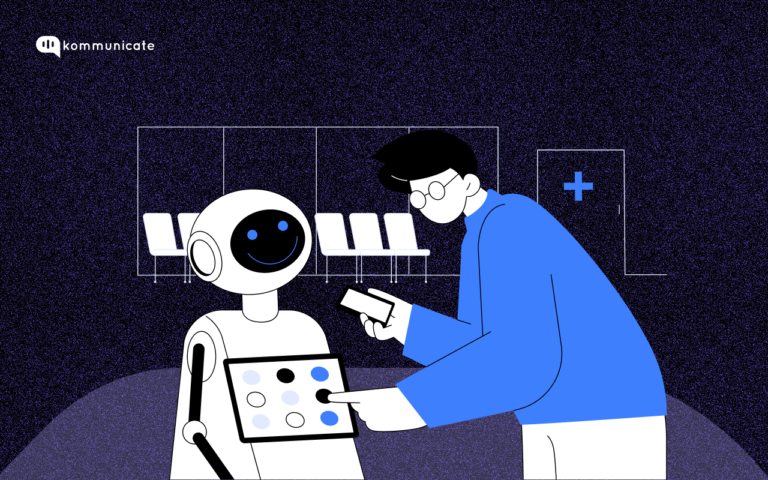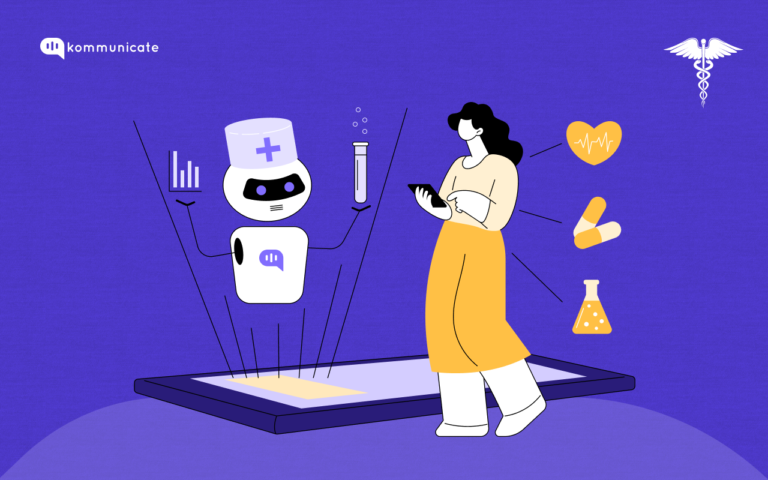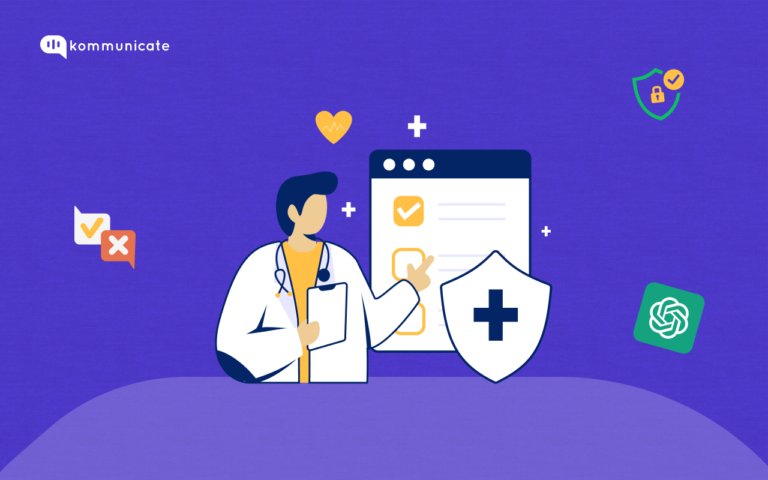Updated on April 19, 2024
Ever since its conception, chatbots have been leveraged by industries across the globe to serve a wide variety of use cases. From enabling simple conversations to handling helpdesk support to facilitating purchases, chatbots have come a long way.
If you were to put it in numbers, research shows that a whopping 1.4 billion people use chatbots today.
Without question, the chatbot presence in the healthcare industry has been booming. In fact, if things continue at this pace, the healthcare chatbot industry will reach $967.7 million by 2027.
There are several interesting applications for healthcare chatbots. If you’re curious to know more, simply give our article on the top use cases of healthcare chatbots a whirl.
It is also important to pause and wonder how chatbots and conversational AI-powered systems are able to effortlessly converse with humans. That too in a language that is simple and easy for us to comprehend.
This is where Natural Language Processing (NLP) makes its entrance.
In order to understand in detail how you can build and execute healthcare chatbots for different use cases, it is critical to understand how to create such chatbots. And this is what we intend to cover in this article.
Let’s start with the most important question.
What is NLP?
Natural language – the language that humans use to communicate with each other.
Programming language- the language that a human uses to enable a computer system to understand its intent. Python, Java, C++, C, etc., are all examples of programming languages.
Imagine a situation where you can communicate with machines and computers without having to use such programming languages. Easy and seamless. Right?
Fortunately, you don’t have to put in a lot of effort trying to imagine such a situation because NLP makes this possible.
Natural language processing is a computational program that converts both spoken and written forms of natural language into inputs or codes that the computer is able to make sense of.
NLP-powered chatbots are capable of understanding the intent behind conversations and then creating contextual and relevant responses for users.
With NLP, you can train your chatbots through multiple conversations and content examples. This, in turn, allows your healthcare chatbots to gain access to a wider pool of data to learn from, equipping it to predict what kind of questions users are likely to ask and how to frame due responses.
Interesting. Right?
We hope that you now have a better understanding of natural language processing and its role in creating artificial intelligence systems. Let’s now move on to the more details.
How do healthcare chatbots using NLP work?
A chatbot that is built using NLP has five key steps in how it works to convert natural language text or speech into code. Let’s explore each of these steps and what it entails.
1. Tokenization
This is the process by which you can break entire sentences into either words. The name of this process is word tokenization or sentences – whose name is sentence tokenization. This is a method of data processing.
Extract the tokens from sentences, and use them to prepare a vocabulary, which is simply a collection of unique tokens. These tokens help the AI system to understand the context of a conversation.
2. Normalizing
Imagine that you are texting your colleague. Naturally, different people have a tendency to misspell certain words, use short forms, and enter certain words in uppercase letters and others in lowercase. Essentially, there is a lot of randomness to the way different people text.
Now, extrapolate this randomness to how people communicate with chatbots. Unless the system is able to get rid of such randomness, it won’t be able to provide sensible inputs to the machine for a clear and crisp interpretation of a user’s conversation. Normalization refers to the process in NLP by which such randomness, errors, and irrelevant words are eliminated or converted to their ‘normal’ version.
For instance:
Input: cn i book an apptmnt with my dr 2day?
Output after normalization: Can I book an appointment with my doctor today?

3. Recognizing entities
Now that a sentence has been broken down (tokenized) and normalized, the system proceeds to understand the different entities in the sentence.
Entities are nothing but categories to which different words belong to. Some examples of entities include Name, Location, Organization, etc. Recognizing entities allows the chatbot to understand the subject of conversation.
For instance, take the sentence – Mary works at Mt. Sinai Medical Hospital, North Dakota.
In this example, the chatbot would recognise Mary as a name, Mt. Sinai Medical Hospital as an organisation, and North Dakota as a location.
Check out our guide on Intents vs. Entities to learn more.
4. Dependency parsing
In natural language processing, dependency parsing refers to the process by which the chatbot identifies the dependencies between different phrases in a sentence. It is based on the assumption that every phrase or linguistic unit in a sentence has a dependency on each other, thereby determining the correct grammatical structure of a sentence.
5. Generation
This is the final step in NLP, wherein the chatbot puts together all the information obtained in the previous four steps and then decides the most accurate response that should be given to the user.
Why should you consider building an NLP-based healthcare chatbot?
One of the most important things to understand about NLP is that not every chatbot can be built using NLP. However, for the healthcare industry, NLP-based chatbots are a surefire way to increase patient engagement. This is because only NLP-based healthcare chatbots can truly understand the intent in patient communication and formulate relevant responses. This is in stark contrast to systems that simply process inputs and use default responses.
You can continually train your NLP-based healthcare chatbots to provide streamlined, tailored responses. This is especially important if you plan to leverage healthcare chatbots in your patient engagement and communication strategy.
As demand for healthcare systems grows, the only way to cut down overhead costs and increase the efficiency of patient engagement is to deploy conversational AI-powered chatbots built using NLP to act as the first point of contact between your patient and healthcare practice.
5 use cases of NLP in healthcare
Here are 5 spheres of healthcare that are being disrupted by NLP technology
1. Disease monitoring:
Imagine the possible lives that could have been saved if more regions around the world knew that a pandemic like COVID 19 has been spreading, before patients in those regions started showing symptoms. Disease surveillance and disease monitoring is an area that NLP finds ready application in. NLP can be used to monitor publicly available information such as news posts, social media feeds and detect possible areas where there is an outbreak of a disease. This will help healthcare professionals to respond rapidly to these outbreaks, possibly saving thousands of lives.
2. Clinical research:
Data analysis is something that a lot of healthcare professionals struggle with, especially considering the vast amount of data that is generated in the field. This is where NLP can be deployed. NLP’s powers can be used to analyze large amounts of clinical data, and this can be in the form of patient records, clinical trial history or other medical literature. Researchers and medical professionals can thereby focus their energies on improving the existing treatment methods, and devise new ways to cure diseases.
3. Personalized treatment:
Using sophisticated NLP technology, healthcare professionals can analyze troves of medical data, including genetics and a patient’s past medical history, to customize the treatment plans. Patients who get this amount of personalized treatment have higher chances of recovery, and this can also help reduce their healthcare costs.
4. Analyzing Medical images:
NLP can be used to analyze medical images, including MRIs and X-Ray images, that will help doctors plan their treatment better. NLP can also aid doctors make an accurate diagnosis of advanced medical conditions such as cancer. With analysis using NLP, healthcare professionals can also save precious time, which they can use to deliver better service.
5. Speech recognition:
NLP can be used by physicians to transcribe notes, which can then be converted easily into a format that is understood by computers. Physicians can use NLP to convert speech to text, and AI has already proven to be invaluable because of its ability to analyze and interpret huge amounts of unstructured data.
Creating a healthcare chatbot using NLP?
Building your own healthcare chatbot using NLP is a relatively complex process depending on which route you choose. Healthcare chatbots can be developed either with assistance from third-party vendors, or you can opt for custom development.
Here’s what this means
Custom DIY Development
In this method of developing healthcare chatbots, you rely heavily on either your own coding skills or that of your tech team.
In order for it to work, you need to have the expert knowledge to build and develop NLP- powered healthcare chatbots. These chatbots must perfectly align with what your healthcare business needs.
Of course, the biggest advantage of this method is the fact that you can customize it to the extent you prefer. However, when you consider factors like time and cost, it may be wiser to consider a third-party vendor.

Building your healthcare chatbot using third-party bot builders
In case you don’t want to take the DIY development route for your healthcare chatbot using NLP, you can always opt for building chatbot solutions with third-party vendors.
For instance, Kommunicate, a customer support automation software, enables users to build NLP-powered healthcare chatbots that are not only customized to their business requirements but also can be built with ease. Their NLP-based codeless bot builder uses a simple drag-and-drop method to build your own conversational AI-powered healthcare chatbot in minutes.
You can check it out here.
Their powerful NLP chatbot builder provides a simple and intuitive interface on a powerful conversational AI system for you to build your healthcare chatbot with ease. In fact, you can build a bot using Kommunicate in just five easy steps. Here’s how:
1. Getting started
First, you need to sign in to Kommunicate using your email ID. Once you are logged in, open the dashboard and then navigate to ‘Bots.’ Click ‘Create A Bot,’ and that will take you to Kompose, Kommunicate’s bot builder.
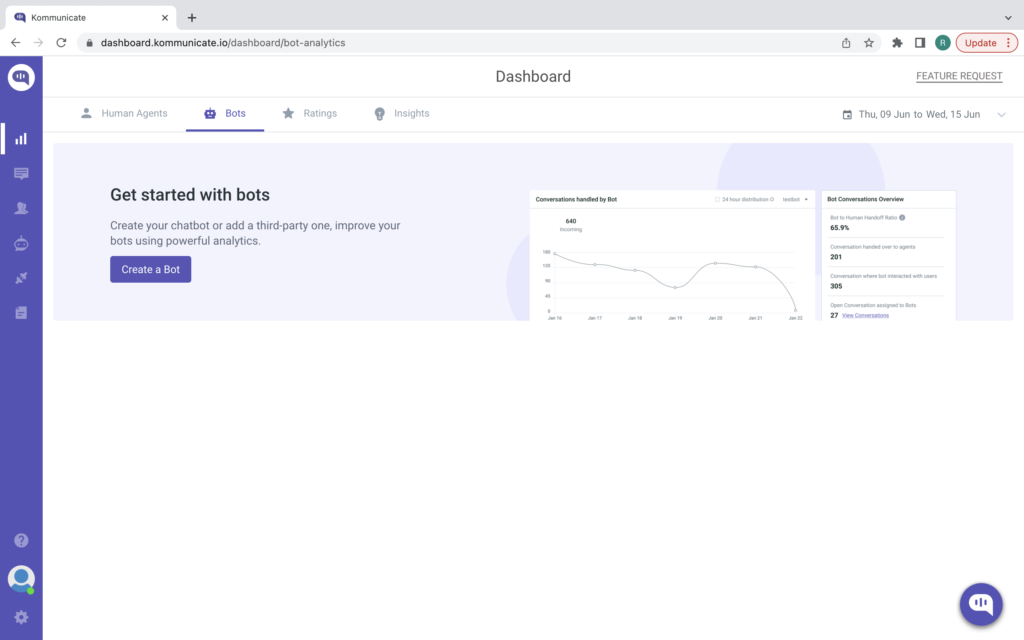
Click ‘Create A Bot’ to start building your bot.
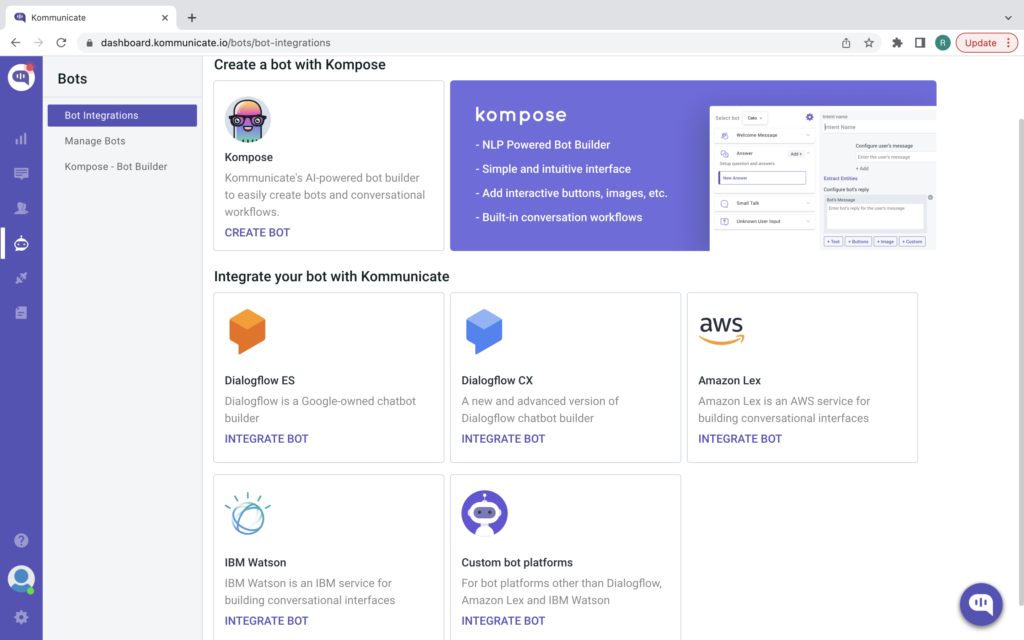
2. Build your bot
Choose from readily available templates to start with or build your bot from scratch customized to your requirements.
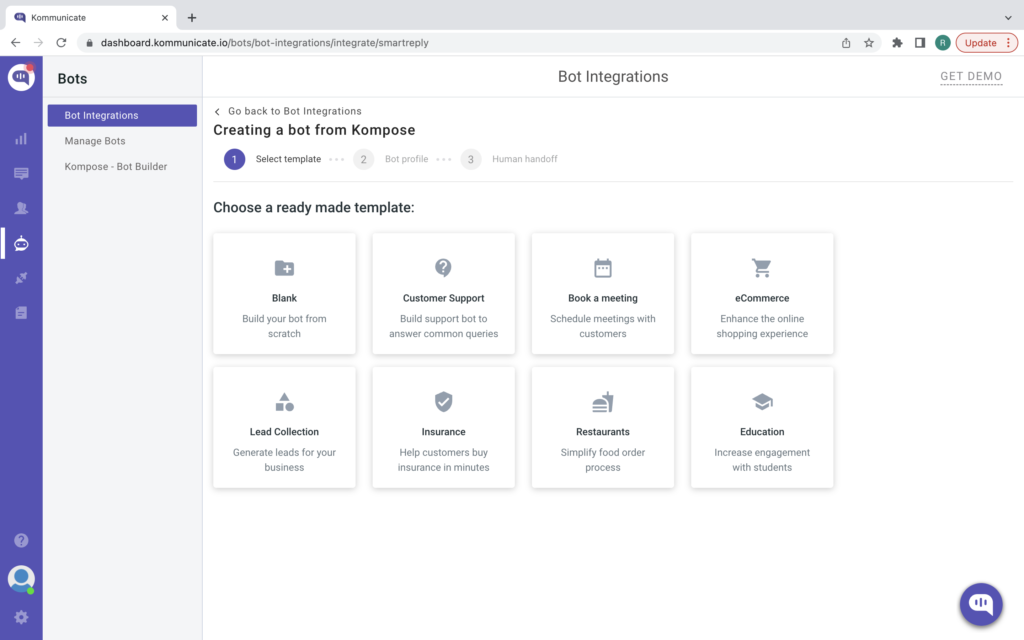
Once you choose your template, you can then go ahead and choose your bot’s name and avatar and set the default language you want your bot to communicate in. You can also choose to enable the ‘Automatic bot to human handoff,’ which allows the bot to seamlessly hand off the conversation to a human agent if it does not recognize the user query.
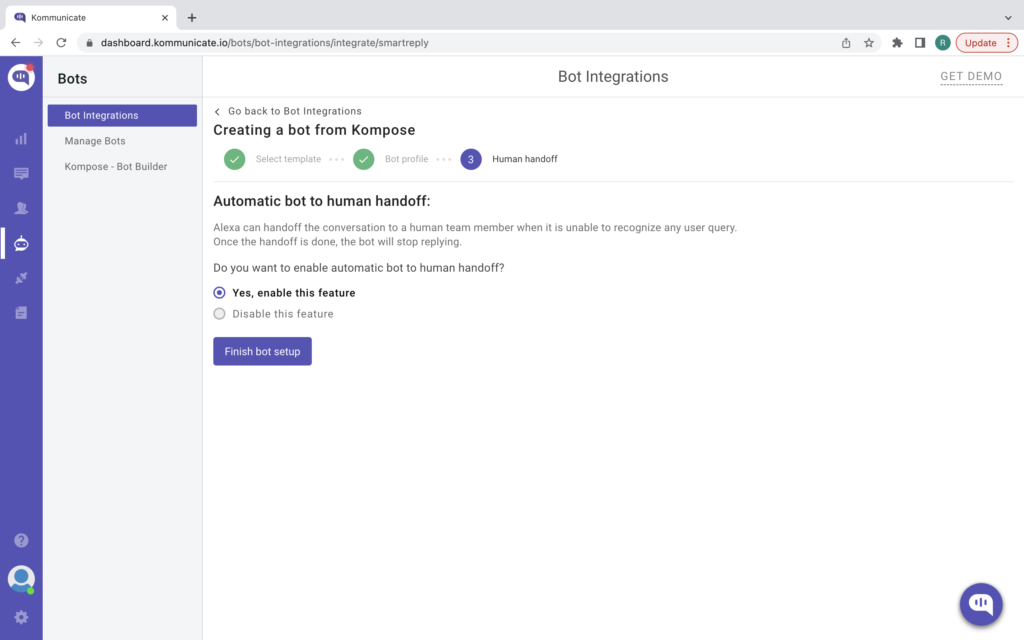
3. Compose the Welcome message
Once you’ve set up your bot, it’s time to compose the welcome message. The welcome message is basically how your bot greets a user. You can add both images and buttons with your welcome message to make the message more interactive.
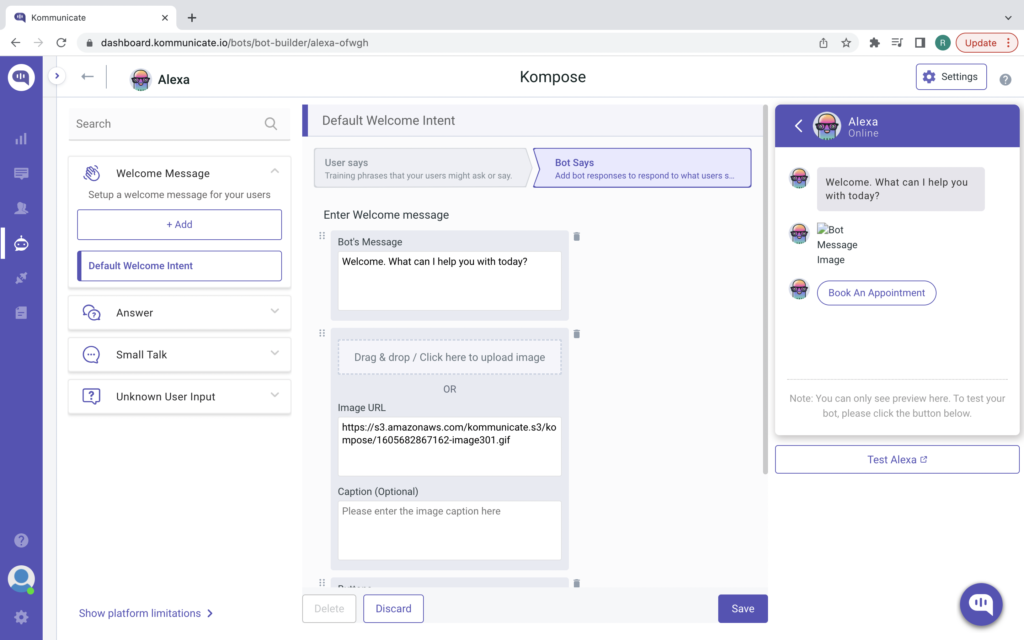
4. Setup questions and answers
The next step is to add phrases that your user is most likely to ask and how the bot responds to them. The bot builder offers suggestions, but you can create your own as well. The best part is that since the bots are NLP-powered, they are capable of recognizing intent for similar phrases as well. The more phrases you add, the more amount of data for your bot to learn from and the higher the accuracy.
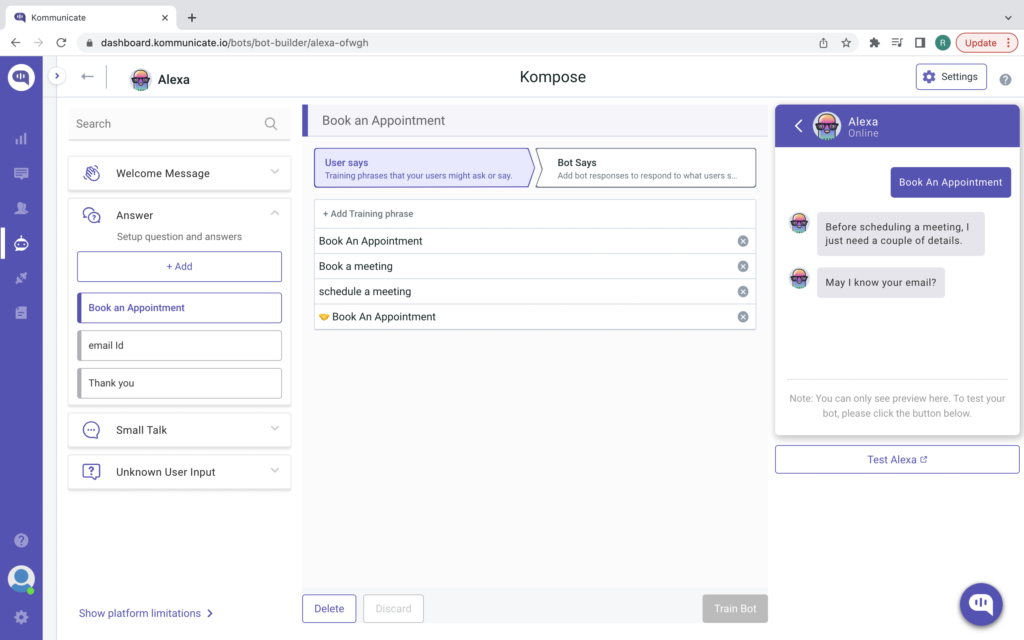
5. Test your chatbot
Your chatbot is almost ready! Now all you have to do is test it.
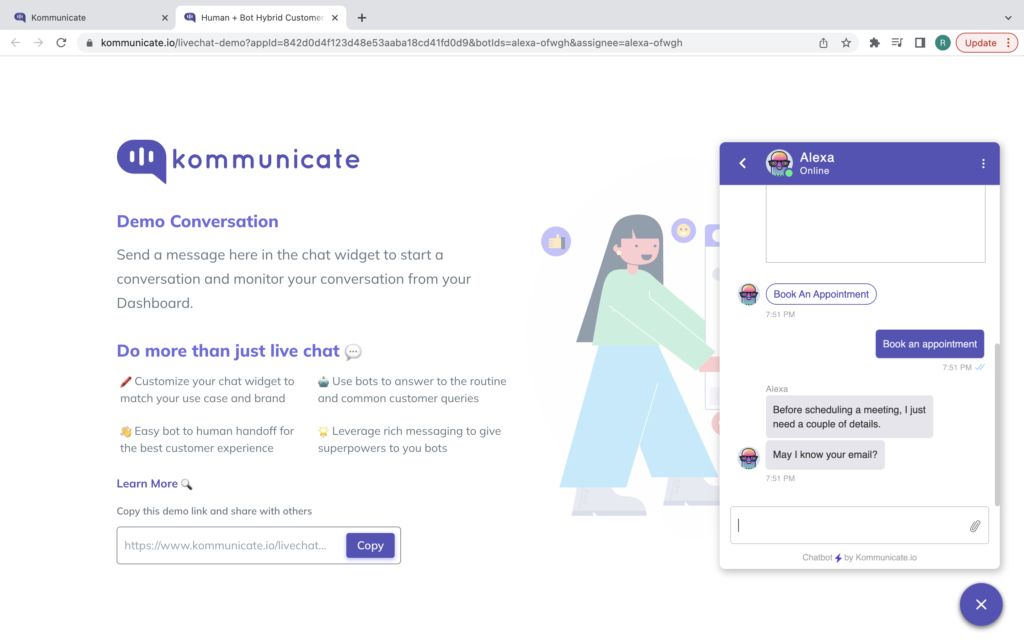
In the chatbot preview section, you will find an option to ‘Test Chatbot.’ This will take you to a new page for a demo.
The chatbot will then display the welcome message, buttons, text, etc., as you set it up and then continue to provide responses as per the phrases you have added to the bot.
Conclusion
Healthcare chatbots are here to stay. What we see with chatbots in healthcare today is simply a small fraction of what the future holds.
These conversational AI-powered systems will continue to play a crucial role in interacting with patients. Some of their other applications include answering medical queries, collecting patient records, and more. And with the rapid advancements in NLP, it is inevitable that going forward, healthcare chatbots will tackle much more sophisticated use cases.
If you’d like to learn more about medical chatbots, their use cases, and how they are built, check out our latest article here.

Naveen is an accomplished senior content writer with a flair for crafting compelling and engaging content. With over 8 years of experience in the field, he has honed his skills in creating high-quality content across various industries and platforms.
At Kommunicate, we are envisioning a world-beating customer support solution to empower the new era of customer support. We would love to have you onboard to have a first-hand experience of Kommunicate. You can signup here and start delighting your customers right away.





